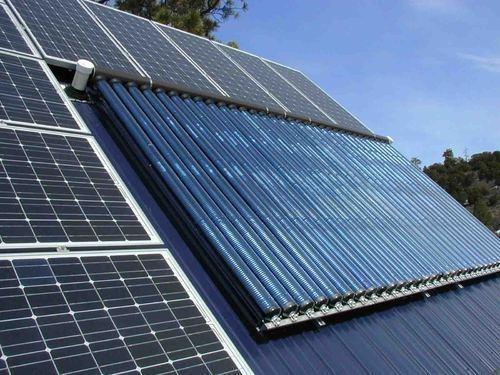
Non-Concentrating Type Solar Heating Products with pros and cons
A solar thermal collector is a device which absorbs heat from the sunlight and transfers the heat to the fluid flowing in contact with it. These devices are used for active solar heating. The main aim of a thermal collector is to collect a maximum amount of heat and transmit this to the fluid. The solar collectors are of different types according to the temperature which they maintain, the construction, shape, etc.
They are broadly classified as:
1. Non-concentrating Collector
2. Concentrating Collector
In this blog, we will restrict ourselves to Non-concentrating Collectors. Concentrating Collectors will be discussed in our next blog.

Non-concentrating Collector for solar heating
Non concentrating collectors have the surface area which absorbs the heat from the sun and transfer it to the working fluid. Types of non-concentrating collector are:
1. Flat Plate Collector
The design and construction of this type of collector are simple. It is a box made up of metal consisting of copper pipes running in parallel called risers. The fluid (typically water) flows through these risers. The top of the box has a dark-coloured absorber plate and the rest of the faces of the box are insulated to prevent the heat losses. On absorbing the radiation from the sun, the circulating water inside the risers heats up. This type of collector is mainly used for domestic purposes where the temperature required is not too high like heating of tanks, pools or tubs.

The plate is constructed in two different ways:
a. Direct heating System– In this method, cold water from a tank is pumped into the plate which gets heated up and this water can be used for various household purposes. This is a kind of Open-loop system.
b. Indirect heating System– In this type of system, a water tank is designed in such a way that it contains a spiral of pipe inside it. The ends of this pipe are connected to the collector. The hot water from the collector flows into the pipes inside the tank and radiates its heat into the tank before returning to the collector. This cycle continues. Hence, it is known as a closed-loop system.
2. Evacuated Tube Collector
The evacuated tube collector uses the fact that under vacuum or, evacuated space, heat losses are very low i.e. vacuum does not let the heat to escape through. Keeping this fact in mind, we design the collector. It is made in the shape of a long glass test tube. Inside each of this test tube, a concentric tube of metal (called the heat pipe) is placed, which carries the working fluid. The space between the heat pipe and glass is evacuated, and hence the name evacuated tube collector. The heat pipes can be painted black as black is a good absorber of heat. Many tubes are connected to a box in which the water flows which is to be heated. This box is connected to a storage tank and acts as the heat exchanger.
These are of two types:
Direct flow evacuated-tube collectors: In this type, a heat pipe is bent in “U” shape where one arm of the U pipe act as inlet and the other arm acts as an outlet. Cold water flows from the inlet, gets heated up in the glass tube and is thrown out of the heat pipe. Since the fluid flows into and out of each pipe directly, the tubes cannot be easily replaced.
Heat pipe evacuated-tube collectors: In this type, the heat pipe is attached to an absorber plate inside a vacuum-sealed glass tube. The heat pipe is filled with a combination of water and a small quantity of alcohol. On absorbing radiation from the sun, the water heats up to form vapours and rise to the top of the pipe. The top portion of the pipe is connected to a copper heat exchanger, called the “manifold”. The heat energy of the vapour is transferred to the water or glycol fluid flowing through the connecting manifold. Once, the heat gets transferred, the vapour cools down to become liquid and gets back in the pipe from the manifold to get reheated again. This cycle continues.
Evacuated tube collectors generate much more heat than the flat plate collector. The reasons are:
1. Evacuated tube has the advantage of vacuum insulation.
2. In a flat plate, only one of the surfaces is exposed to sunlight and the rest are insulated, thus the maximum heat is generated only when the sunlight falls on the surface perpendicularly. But, in evacuated tubes, the surface which absorbs the sunlight is cylindrical, thus the sun rays always fall perpendicular to it.
Pros of Non-Concentrating Type Collectors
- Fuel cost is nil.
- Free energy of the sun is directly used.
- This system is free from pollution.
Cons of Non-Concentrating Type Collectors
- The equipment can be a little costly.
- The installation requires space. So, there is a constraint of area.
But, ultimately they harm the environment in the minimal way and can be used for domestic purposes easily. Thus, solar energy proves to be a better source and eco-friendly in nature.









Leave a Reply